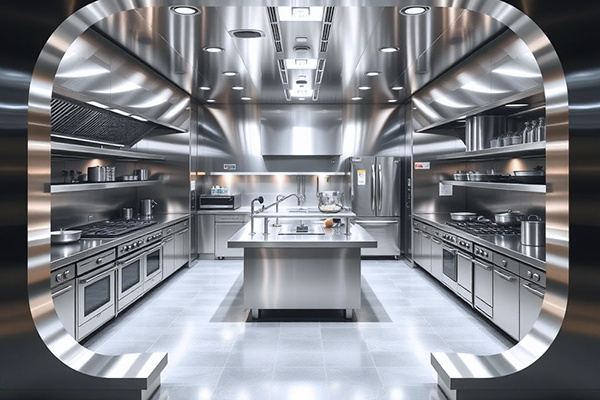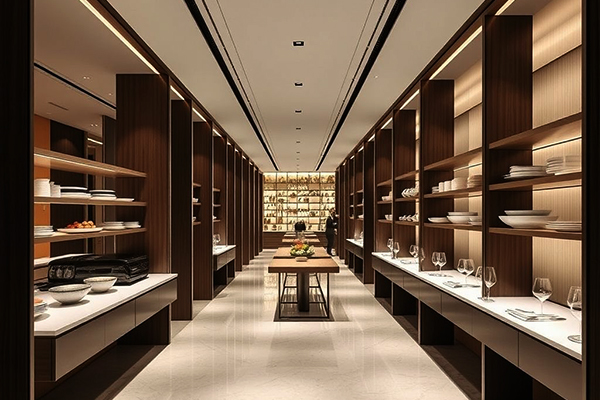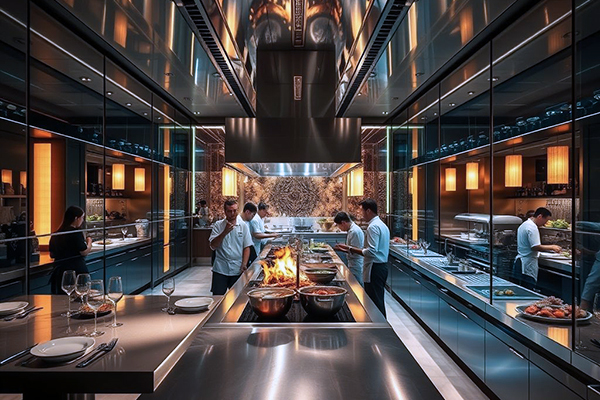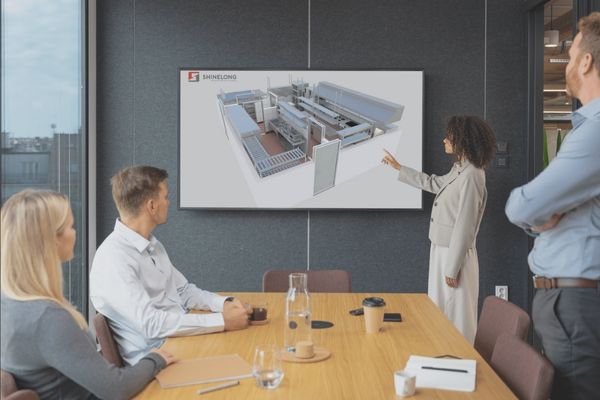The gastronomic sanctuary of a star hotel is an area where thermodynamics meets high design.
How To Design A Star Hotel Kitchen : Guide & Trends
Behind every Michelin-starred meal and flawlessly executed banquet lies an unsung hero: the hotel kitchen. More than a workspace, it's a meticulously choreographed ecosystem where thermodynamics waltz with human ingenuity. Here's how to design a hotel kitchen that elevates both staff efficiency and guest perception, guiding you to bring the luxury culinary experience to life.
The spatial choreography alone reveals volumes. Star-rated kitchens function as gastronomic laboratories, their floors mapped like surgical theaters. Cold storage vaults maintain precise microclimates for aging wagyu and preserving truffle terroir, while dedicated plating ateliers glow under 5,000 Kelvin LEDs to ensure every quenelle gleams. Contrast this with economy kitchens, where a single stainless steel counter might moonlight as a butcher block by dawn and pastry station by noon—a study in pragmatic compromise.
Equipment choices further delineate these worlds. Luxury properties invest in culinary instruments worthy of a Bond villain's lair: combi-ovens that adjust steam levels to the percentage point, induction grids that sear scallops while charging the chef's tablet. Budget counterparts opt for appliances that prioritize endurance over elegance—the kitchen equivalent of reliable hiking boots rather than hand-stitched Oxfords.
Yet the true divergence lies in philosophy. A luxury hotel kitchen isn't merely a food factory; it's a stage set where copper pans hang as deliberately as gallery art, where custom millwork conceals industrial-grade refrigeration behind walnut veneers. Meanwhile, economy kitchens embrace an unapologetic utilitarianism—fluorescent lights lay bare every scratch on laminate surfaces, because when your breakfast buffet feeds 300 daily, poetry takes a backseat to portion control.
Operational scale compounds these contrasts. The typical star hotel kitchen orchestrates a gastronomic symphony: 6 AM croissants for the Parisian executive, midday ceviche for poolside service, midnight truffle risottos en suite—all while prepping tomorrow's 500-guest gala. This demands military-grade logistics software tracking saffron threads and linen stocks in real time. Budget kitchens? Their triumph lies in doing more with less—a single team mastering eggs Benedict and banquet chicken with Zen-like efficiency.
Revolutionize the Principal Kitchen Layout
Every great kitchen begins with understanding the ballet of movement. The kitchen layout must serve as both compass and canvas, guiding chefs through their daily symphony while accommodating the silent demands of cold storage and food service logistics.
"We don't design kitchens—we engineer culinary theaters," remarks Claudia Forte, lead designer at Milan's Studio Culinario. "The magic lies in making 80 sqm feel like 120 through vertical choreography." This is the crucial part of kitchen layout, and it's also the fundamental difference between luxury and economy hotel kitchens.
Maybe you were wondering and felt confused about the principles of designing starred hotel kitchen layouts as you read this. So, I'll recommend three major layout philosophies that dominate luxury spaces:
The Celestial U
An embrace of stainless steel and efficiency, this horseshoe configuration positions cooking equipment along three walls with a central plating island. Ideal for properties serving multiple dining areas, its success hinges on zoning: raw prep flows westward to cold storage, while hot lines face east toward service elevators.

The Gallery Passage
Adopted by Tokyo's Park Hotel in their 2023 renovation, this streamlined corridor layout uses retractable partitions to morph from breakfast buffet staging to à la carte precision. The secret? Vertical storage space integration—motorized shelves descend from the ceiling at timed intervals.

The Open Chronicle
For resorts where cooking is performance art, glass-encased kitchens now incorporate 'chef's confessionals’— soundproof booths where staff consult digital management systems without breaking the guest illusion.

Select the Smart Kitchen Equipment
Selecting commercial kitchen equipment for a five-star property isn't about filling a spec sheet—it's curating tools that whisper reliability to chefs and sustainability to accountants.
Consider the quiet revolution of induction technology. Where gas ranges once roared, precision electromagnetic fields now simmer sauces within 0.5°C accuracy. The Savoy London's 2024 upgrade saw 37% energy savings through Vollrath Mirage Pro surfaces that double as charging pads for digital recipe tablets.
"Multi-use equipment is the unsung hero," explains Mathias Dahlgren, a renowned executive chef. "Our intelligent cooking tech handles 86% of proteins—from sous-vide quail to slow-roasted venison. It's not just machinery; it's our third sous-chef."
When specifying equipment for a starred hotel kitchen, there are several factors to consider. First and foremost is the functionality of the equipment. You also need to factor in energy costs and maintenance costs. Here's how you can allocate your budget:
| Percentage | Category | Equipment |
|
30% |
Workhorses |
Combi-ovens, Blast Chillers |
|
25% |
Energy-Efficient Infrastructure |
Heat Recovery Hoods, Solar-Assisted Steamers |
|
20% |
Future-Proofing |
AI-Enabled Maintenance Sensors |
The Trends of Luxury Hotel Kitchen Design
The modern luxury kitchen is more than just a production hub—it's a statement of sustainability and a cultural touchpoint:
Biophilic Integration: Singapore's Oasia Hotel incorporates living herb walls in prep areas, using hydroponic roots cooled by refrigeration exhaust. This closed-loop system reduces produce waste by 60%.
Digital Twin Technology: 3D simulations now predict workflow bottlenecks before construction. Hotel Marcel New Haven, for example, tested 127 layout variations virtually to optimize kitchen efficiency during peak hours.
As we move forward, remember: technology should enhance intuition, not replace it. The ideal kitchen combines a chef's instinct with engineering's logic—a space where copper pans still sing, even as sensors monitor their decibels.

Since Shinelong was established in Guangzhou in 2008, we have made great strides in the fields of commercial kitchen planning and kitchen equipment manufacturing.
IF YOU HAVE ANY QUESTION,PLEASE CONTACT US.
WhatsApp: +8618902337180
WeChat: +8618924185248
Telephone: +8618924185248
Fax: +86 20 34709972
Email: info@chinashinelong.com
After-Sales Contact
Telephone: +8618998818517
Email: service@chinashinelong.com
Add: No. 1 Headquarters Center, Tian An Hi-tech Ecological Park, Panyu Avenue, Guangzhou, China.



















